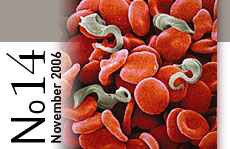 | |

R&D DIRECTOR DNDI
There are two scenarios. The first concerns the parasites that cause sleeping sickness (or human African trypanosomiasis – HAT), Trypanosoma brucei gambiense (Central and West Africa) and T. b. rhodesiense (East Africa). Last summer the extraordinary genome of these parasites was published in the journal Science. Some of the fruits of this research are now showing just how advanced is our understanding of the structure and function of these pathogens. One recent paper(1) from Sara Melville’s group at University of Cambridge (UK) has shown that up to 75% of some T. brucei chromosomes comprise genes devoted to evading the immune response – another confirmation that vaccines for this disease are not a reality. A second paper(2) from Paul Englund’s group at Johns Hopkins (USA) has used the genome to identify enzymes that synthesise fatty acids for the parasite, posing the question, could this be a novel drug target?
The second concerns the disease - HAT. Although we are moving slowly to an understanding of the immunopathology of the disease, many important questions remain unanswered – how does the parasite enter the central nervous system (CNS) to cause stage II disease? How can we tell at what point the disease progresses from the early haemolymphatic (1st stage) to the late CNS (2nd stage) infection? What is the status of the blood-brain-barrier (that tight layer of cells that separates the blood from neurons – protecting the brain from toxins at the same time) during infection – does it become leaky? These are just some of the gaps in our knowledge that we consider important for the development of improved new HAT treatments and that will give us the chance to move away from arsenicals and other difficult drugs.
Today, DNDi is involved in a major clinical research effort for patients suffering from stage 2 sleeping sickness (see NECT Project). If successful, a simplified combination regimen of eflornithine with nifurtimox could replace the more toxic melarsoprol as a first line in many places, and it will be more easy to use than eflornithine alone. But this improved treatment option will not bring the radical change needed to effectively control sleeping sickness and increase access to treatment for neglected patients. For that, new discovery research is needed.
To bring new drugs forward DNDi is taking a multi-pronged approach. It is necessary to define the needs and the target product profile (see Rob Don, DNDi newsletter 12), and then to identify totally new, active pharmacophores (compounds that kill the trypanosome but not mammalian cells) by exploiting recent molecular knowledge, and build on the potential of compounds known to have activity against these parasites (see Discovery and preclinical projects). Problems remain. To mention three, there is a need for better development process models by delivering effective drugs through more rapidly, for a strengthening of clinical trial capacity in the HAT-endemic regions (see Hat Platform), and for improved diagnostics to enable full evaluation of new drugs in clinical trials. DNDi cannot do all this alone and aims to form partnerships with other organizations (see Nect Project) to ensure that new, affordable, and effective treatments can be delivered to patients.
1. Callejas et al. Genome Res. 2006;16:1109-18.
2. Lee et al. Cell. 2006;126:691-9.
Editor: Ann-Marie Sevcsik - Tel: +41 22 906 9230 - Fax: +41 22 906 9231 - www.dndi.org